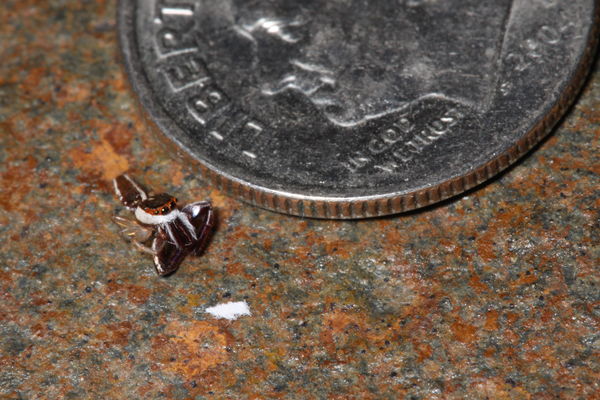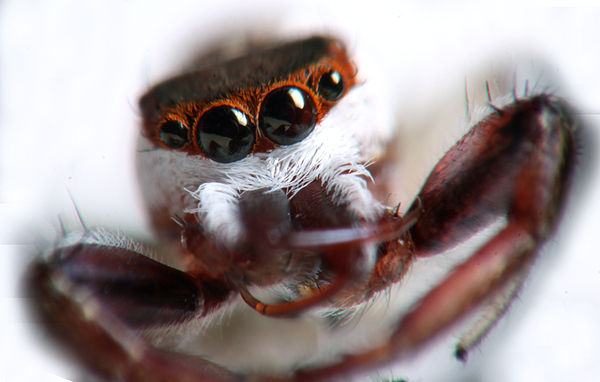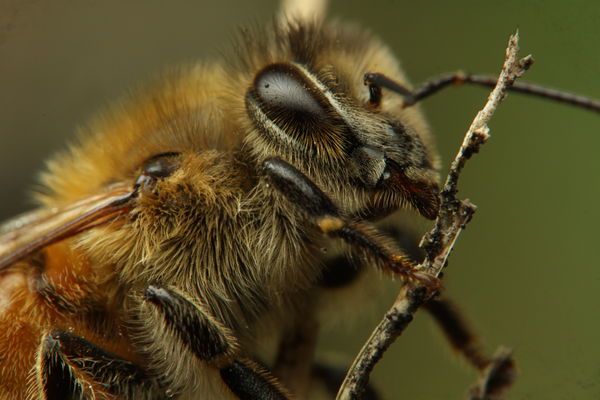Macro question
Apr 8, 2014 11:40:12 #
Just curious. When shooting with a macro lens that produces 1:1 ratio, what happens when you use that lens on a cropped sensor camera, ie, Nikon D7100 with a Nikkor 105 2.8 micro? Does the ratio change, and if so, which way?
Apr 8, 2014 11:46:36 #
shutterbob wrote:
Just curious. When shooting with a macro lens that produces 1:1 ratio, what happens when you use that lens on a cropped sensor camera, ie, Nikon D7100 with a Nikkor 105 2.8 micro? Does the ratio change, and if so, which way?
This is kinda a hard question to answer... The actual ratio 1:1 refers to the size of the image that is produced on the sensor so technically the ratio does not change, but if two uncropped images are viewed taken with the same 1:1 aspect ratio, one picture taken with a full frame camera and one taken with the cropped camera the image from the cropped camera would appear to be 150% larger than on the full frame camera.
So I guess that the answer is yes and no.... totally confusing.
A when you consider what a crop sensor camera does it is pretty simple, the smaller sensor is simply cropping the image that the lens is projecting to the sensor plane because of its smaller size.
Apr 8, 2014 11:53:30 #
Apr 8, 2014 12:09:43 #
Bob, I would not get to hung up on if you are shooting at 1.5:1 or 1:1. Just know that when compared to a full frame camera even though you are technically shooting at 1:1 your image would appear to be shot at 1.5:1. But really that makes little difference, most macro shooters are going to crop their images anyway so that they can display their subject as large as they can while preserving image quality... so in the end the question you are posing is not really very significant. The lens that you are asking about is going to preform as well as any macro lens out there so the question is purely academic as unless you change over to something like Canon and purchase a MP-E 65 that goes up to 5:1 mag, but as it is 1:1 is all the magnification that your going to get out of a conventional lens on your camera.
There are other things that you can do to increase magnification beyond the 1:1 ratio such as by adding extension tubes, or purchasing filters which will magnify your image... or in my case I use wide angle lenses mounted backwards to my camera.... But as far as aspect ratio it is really something that you should not get to hung up on... too many people think far too hard about the difference between aspect ratios on a full frame and a crop sensor camera. What is important is understanding the camera that you have.
There are other things that you can do to increase magnification beyond the 1:1 ratio such as by adding extension tubes, or purchasing filters which will magnify your image... or in my case I use wide angle lenses mounted backwards to my camera.... But as far as aspect ratio it is really something that you should not get to hung up on... too many people think far too hard about the difference between aspect ratios on a full frame and a crop sensor camera. What is important is understanding the camera that you have.
Apr 8, 2014 12:12:49 #
Blurryeyed wrote:
..........................
But as far as aspect ratio it is really something that you should not get to hung up on... too many people think far too hard about the difference between aspect ratios on a full frame and a crop sensor camera. What is important is understanding the camera that you have.
But as far as aspect ratio it is really something that you should not get to hung up on... too many people think far too hard about the difference between aspect ratios on a full frame and a crop sensor camera. What is important is understanding the camera that you have.
Well stated Blurry. By the way, I like your new avatar. 8-)
Apr 8, 2014 12:43:11 #
Blurryeyed wrote:
Bob, I would not get to hung up on if you are shoo... (show quote)
Thanks. That pretty much answers my question. I'm pretty happy with the images I am getting, I was just curious as to what it is that I see when using on my D7100. :thumbup:
Apr 8, 2014 14:58:20 #
amehta
Loc: Boston
shutterbob wrote:
Just curious. When shooting with a macro lens that produces 1:1 ratio, what happens when you use that lens on a cropped sensor camera, ie, Nikon D7100 with a Nikkor 105 2.8 micro? Does the ratio change, and if so, which way?
I believe you still get a 1:1 image, but of a smaller object. With a FF camera, you can get a 1:1 image of a 24x36mm object. With a APS-C camera, you can get a 1:1 image of a 16x24mm object.
The only "magnification" that happens with an APS-C camera is when displaying the images at the same size, whether it's a print or a monitor. The APS-C image needs to be digitally enlarged by an extra 1.5x factor.
Apr 8, 2014 15:05:19 #
amehta wrote:
I believe you still get a 1:1 image, but of a smaller object. With a FF camera, you can get a 1:1 image of a 24x36mm object. With a APS-C camera, you can get a 1:1 image of a 16x24mm object.
The only "magnification" that happens with an APS-C camera is when displaying the images at the same size, whether it's a print or a monitor. The APS-C image needs to be digitally enlarged by an extra 1.5x factor.
The only "magnification" that happens with an APS-C camera is when displaying the images at the same size, whether it's a print or a monitor. The APS-C image needs to be digitally enlarged by an extra 1.5x factor.
If you are taking a picture of a 10mm object it will be 10mm on the sensor, it does not matter if the sensor is 36mm wide or 24mm wide, the image on the sensor will be 10mm. The biggest difference between the different sensors is the smaller sensor will because of its size crop the image. The image is still projected the same to the sensor plane, the smaller sensor dose not capture the entire image.
Apr 9, 2014 05:33:30 #
shutterbob wrote:
Just curious. When shooting with a macro lens that produces 1:1 ratio, what happens when you use that lens on a cropped sensor camera, ie, Nikon D7100 with a Nikkor 105 2.8 micro? Does the ratio change, and if so, which way?
http://www.uglyhedgehog.com/t-161859-1.html
Apr 9, 2014 07:48:10 #
Blurryeyed wrote:
Bob, I would not get to hung up on if you are shoo... (show quote)
Your statement about "aspect ratios" is misleading. Aspect ratio means the ratio between the width and height of the image. It has no bearing on or relation to the sensor size. Rob.
Apr 9, 2014 08:14:17 #
shutterbob wrote:
Just curious. When shooting with a macro lens that produces 1:1 ratio, what happens when you use that lens on a cropped sensor camera, ie, Nikon D7100 with a Nikkor 105 2.8 micro? Does the ratio change, and if so, which way?
1 To 1 ratio refers to the scale (proper size) of a subject, No magnification involved.
I should think that when shooting in macro you would want the proper scale
insects, birds, butterflies ect. Magnified images have their place,
Apr 9, 2014 09:04:13 #
floral43 wrote:
1 To 1 ratio refers to the scale (proper size) of a subject, No magnification involved.
I should think that when shooting in macro you would want the proper scale
insects, birds, butterflies ect. Magnified images have their place,
I should think that when shooting in macro you would want the proper scale
insects, birds, butterflies ect. Magnified images have their place,
Actually you are wrong, it is all about magnification, 1:1 does refer to magnification as it means that the image is projected onto the film or sensor plane at life size or 1X... most lenses have a magnification ratio significantly smaller than 1:1 in fact many zoom lenses that advertise themselves as having macro capabilities don't even come close to macro, they are closeup lenses that have magnifications somewhere in the range of 0.2:1 or 1/5th lifesize onto the sensor.
For most macro shooters magnification is very important, macro is about seeing in detail things that you would not be able to see with your naked eye....
Below I am attaching two photos to demonstrate what I am talking about, the first photo is shot at 1:1 as the very small jumping spider is next to a dime, not a quarter but a dime....
The second photo of the same spider was shot at about 4:1.. Not great photos but they demonstrate my point, this was one of my very early attempts at reversed lens and even worse I had accidentally killed that spider when chilling it to slow it down.... The third photo is of bee shot at 3:1, I think that high magnification macro is more interesting than just close ups. Close ups of flowers can be very rewarding, but when you get into bugs you want to see the eyes and other detail that a close up will not provide.
Apr 9, 2014 10:13:25 #
Blurryeyed wrote:
Bob, I would not get to hung up on if you are shoo... (show quote)
Didn't recognize you with the new "face" you posted. Nice smile ... :lol: :lol: :lol:
Apr 9, 2014 10:22:59 #
amehta wrote:
I believe you still get a 1:1 image, but of a smaller object. ...
You are correct.
A 1:1 macro image is simply one in which the image on the sensor is the same size as it is in real life. So 36mm on a ruler would stretch from side to side on a full frame sensor but on a 1.5 crop sensor you would only see 24mm.
But don't get hung up on the ratio. What is important is how big you want the subject to appear in your image. Whether that ends up as a true macro shot or just a very close close-up is just hair splitting.
Apr 9, 2014 10:56:03 #
winterrose wrote:
Your statement about "aspect ratios" is misleading. Aspect ratio means the ratio between the width and height of the image. It has no bearing on or relation to the sensor size. Rob.
Yes, I misused the term.. Thanks for correcting me.
If you want to reply, then register here. Registration is free and your account is created instantly, so you can post right away.









